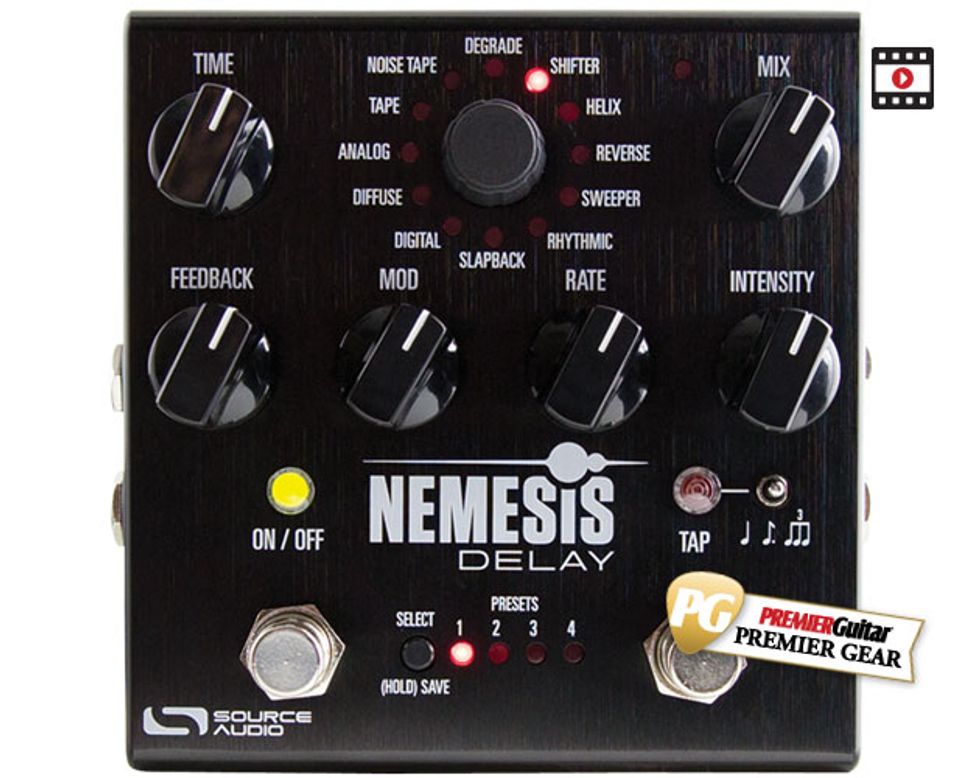Source Audio’s new One Series pedals were designed, in part, to make the company’s potent sound-shaping tools more accessible and easier to use. At a glance, the new Nemesis digital delay—with seven knobs, two switches, two push buttons, two footswitches, and a raft of I/Os—might look like a step backwards along that path. But in fact, it’s an intuitive and fantastically fun way to explore the possibilities of digital delay and create very personal variations on classic and more new-fangled echo sounds.
Like all One Series effects, Nemesis offers the potential of deep editing and customization through the company’s free, downloadable Neuro app. What’s impressive about Nemesis, however, is how sonically flexible the unit is before you dive into that second level of tailoring. Whether you plug and play or go further, this is a powerfully varied delay machine.
Echoes from a Frenemy
Tech-averse players haven’t always found Source Audio pedals approachable. So the Darth Vader aura conveyed by the black enclosure and ominous name might seem like an odd choice. Such perceptions are overcome quickly by plugging in, twisting knobs, and making sounds—a process the very user-friendly Nemesis rewards readily, and with engaging sonic results.
Time, feedback, and mix controls all work like they would on any basic delay. The mod and rate knobs control the depth and speed of the modulation texture associated with each delay type. The intensity knob is the real wild card. This impressive little control changes roles depending on the delay type, adding a wide range of additional color and texture to each delay engine—from EQ filtering on the tape and analog delays, to aliased sounds on the bit-crushing degrade delay, and scale intervals on the pitch-shift delay.
The centerpiece of the control set is the delay engine selector. It offers a dozen departure points from which you can explore the Nemesis’ formidable echo-shaping powers. Many of the delay engines are familiar. There are tape and analog simulations, ultra-high-resolution digital delays, and slapback. But there’s also a reverse delay, a reverse/octave delay, a pitch-sifting delay, and a sweeping-filter delay that ranges from subtle to extreme. The tap-tempo control can be tailored with a division switch that moves between quarter, dotted eighth, and triplet settings. It also doubles as a hold or freeze switch—an awesome feature that opens up all kinds of improvisational, on-the-fly uses for your echo textures.
For players that work with more than a single guitar and amp there are more features still: MIDI I/Os, stereo I/Os, USB connectivity, an assignable expression pedal input, and, of course, the Neuro app interface. Presets are also available and easy to program with the dedicated preset button.
Sonic Kicks from the 12 Chambers
Navigating the 12 delay engines (you can download an additional dozen via Neuro) reveals how thoughtfully integrated each control is within the basic delay voice—and how profoundly those controls can reshape otherwise familiar echo types. The modulation controls are the most obvious and accessible way to reshape a familiar delay sound. At modest settings, the modulations tend to feel like very natural and integral parts of the delay tone. Within the analog and digital engines, for instance, they sound like light chorus—a natural fit for the ’70s and ’80s musical textures most associated with those echo types. In the tape modes, light modulation provides convincing replication of mechanically derived pitch modulation. At more extreme modes, however, the modulation controls radically transform the delay voices. Lovers of warped sci-fi textures will rejoice.
Ratings
Pros:
Powerful, accessible, and easy-to-use sound-sculpting tools. Neuro app is easy to navigate. Rangeful controls. Great organic delay sounds.
Cons:
None.
Tones:
Ease of Use:
Build/Design:
Value:
Street:
$299
Source Audio Nemesis Delay
sourceaudio.net
Nemesis’ super-long delay times mean you can stack sounds over very elongated, almost loop-like durations and intervals—a technique that’s especially effective at high feedback levels. Used with the sweeper and reverse settings, it enables spacious, time-warping, wide-angle soundscaping. Tape settings, meanwhile, take on a cool, lo-fi vaporousness—particularly when you introduce darker repeat textures with the intensity control.
Nemesis’ less obvious features, like the hold or “freeze” function, have equally profound sound-shaping power. In sweeper mode, for example, the hold function adds synth-like functionality. By playing cyclical arpeggios and keeping the hold button depressed with my foot, I improvised (endlessly, it seemed) on variations of Pete Townshend’s spiraling Lowery/EMS interlude from “Won’t Get Fooled Again.” It’s a very cool and easy way to expand and transform your guitar’s vocabulary while retaining its sonic essence.
The Neuro app is one of the Nemesis’ biggest assets, and one of the most interesting features is the sharable presets function. I suppose there’s a potentially compelling “social” function associated with this tool. But the practical possibilities of sharing precise settings (especially those created in the Neuro sound editor) with a musical collaborator who can then upload those settings are intriguing—especially in recording situations. The Neuro editor, by the way, is both easy to download and use—even on a small iPhone screen. It provides extra delay engines including dub, lo-fi retro, oil can, and warped vinyl, as well as dozens of possible parameter adjustments for minutiae like “wow modulation noise,” pan settings, and much more. It’s a very powerful supplementary tool for an already powerful standalone delay.
The Verdict
Nemesis is approachable and powerful at the simplest level. And for that, Source Audio deserves heaps of praise. But the real beauty of Nemesis is the ease with which a player can access and apply its deeper functionality and most radical sounds. Nemesis can shine dishing authentic slapback sounds at the grimiest, most beer-soaked punkabilly gig—or perform precise sound-sculpting functions in the hands of a top-tier producer or engineer in a state-of-the-art studio. The world of musical possibilities it makes available between those extremes is a joy to explore.
Watch the Review Demo:









![Rig Rundown: Russian Circles’ Mike Sullivan [2025]](https://www.premierguitar.com/media-library/youtube.jpg?id=62303631&width=1245&height=700&quality=70&coordinates=0%2C0%2C0%2C0)


























